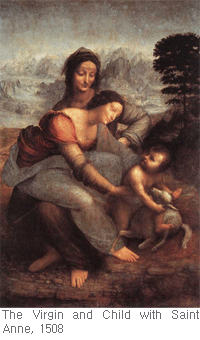 Anger over Louvre’s plan to clean a Leonardo
Anger over Louvre’s plan to clean a LeonardoSpecialists fear artist’s “smoky finish” effect may be harmed
paris. Conservators approach works by Leonardo da Vinci at their peril for fear of creating a storm—especially in France. The Louvre’s latest attempt to conserve a masterpiece by the artist, The Virgin and Child with Saint Anne, 1508, has yet again sparked a wave of debate about cleaning paintings, even if they are dirty and discoloured.
The proposal to clean the work was first mooted at a two-day conference held at the Louvre in June 2009, attended by key Leonardo scholars such as Martin Kemp, emeritus professor at the University of Oxford. “The event at the Louvre was a genuine scholarly exercise. The work is tricky; there are some rather nasty scars and very ugly, discoloured retouching,” he says. “It’s not just a question of cleaning off the dirt but ensuring that the internal colour balance is not disturbed.”
Previous restoration attempts have also proved controversial. According to our sister paper Le Journal des Arts, the Louvre abandoned plans to conserve the work in 1994 because the solvents used to remove varnish risked damaging the paint layers beneath. In autumn 2010, the Louvre decided to try again, this time backed by a scientific committee made up of specialists, including Larry Keith of the National Gallery in London, who last year restored Leonardo’s The Virgin of the Rocks (around 1491-1508). Vincent Pomarède, the project leader and keeper of paintings at the Louvre, said that the aim was “to solve the problem of the thick varnish that pulls on the paint layers, creating an uneven surface”. Pomarède’s solution involves thinning the layers applied in the 19th and 20th centuries, leaving a film of varnish eight to 12 micrometres thick, rising to 25 micrometres across the faces of the figures.
This strategy, which would still involve the use of solvents, raises fears that the sfumato, Leonardo’s “smoky finish” effect, could be compromised. Michel Favre-Félix, the president of the Association for the Respect and Integrity of Artistic Heritage, is concerned, saying: “Leaving a layer of varnish is preferable but the deep infiltration of the solvents is the core issue. The varnish and sfumato are so closely allied [that] we must ascertain, before moving ahead, whether the sfumato will be harmed by the solvents.”
Pomarède insists his approach is safe: “At no point will we be in contact with the paint layers… the restoration is essential if we want to preserve this masterpiece, which is under threat because of the raised micro-blemishes on the surface. These are due to the oxidised varnish layers.” He adds that his restoration processes were discussed and approved during the Louvre conference. Italian art historian Pietro Marani, who is on the scientific committee, says that the painting is not in jeopardy. Kemp adds: “If the Louvre proceeds in the way it suggests, I envisage no problems.”
 Anger over Louvre’s plan to clean a Leonardo
Anger over Louvre’s plan to clean a Leonardo